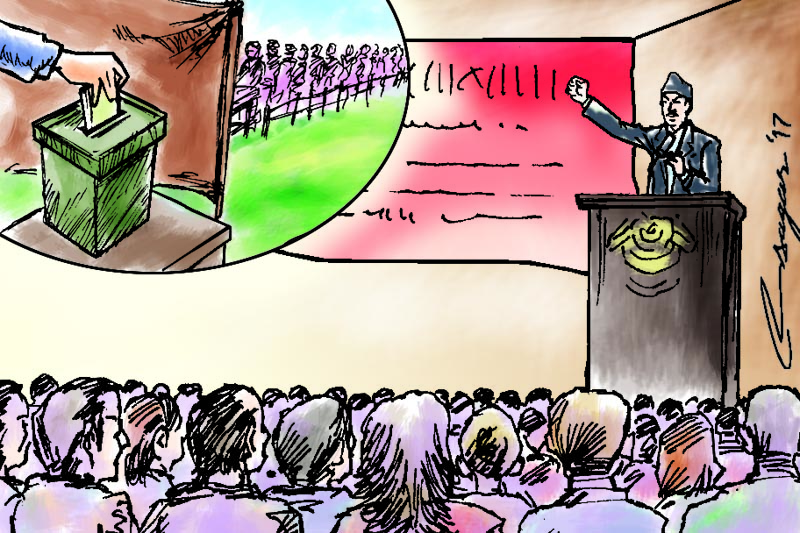Re-advent of democracy: Promises to keep
The current practice of democracy needs to change if it is to survive. And the way forward is deliberative democracy in which leaders and citizens come together and deliberate on issues and come up with probable solutions
We have been defining democracy as “ government of the people, by the people and for the people”. This means that it is the people who choose the people by whom they want to be governed.
This is the way in most democratic countries today. It mostly elects a government made up ‘of people’ and made ‘for the people’. But, is the government actually made ‘by the people’?
The current democracy has defined provisions for elections at a regular interval. It entails three basic steps: political parties field candidates, eligible citizens go and vote, and winners participate in the governance for a specified number of years.
The first step in any election is for the political parties to field candidates in the elections. The National Democratic Institute has identified three parameters for intra-party democracy in selecting candidates: institutionalization, decentralization and inclusiveness.
Institutionalization requires the development of well-defined and publicized procedures to make the rules of candidate selection process clear. Decentralization determines the extent to which the power is devolved to party branches.
Inclusiveness determines the possibility of every registered voter or individual to give direct vote in the candidate selection. We need to determine if the candidate selection process is institutionalized, decentralized and inclusive.
If we look at the candidate selection process of the political parties in Nepal, it is not institutionalized, somewhat decentralized and barely inclusive. The rule of candidate selection process is vague and unclear, or in most cases there are no rules at all.
Even party portfolio holders do not know how certain candidates got nominated. The central office has delegated some powers to its party branches to recommend their candidate but is always prone to last minute intervention from the central leadership.
The candidate selection is finalized by a handful of powerful members wherein the voices of the active members are not usually taken into consideration. It is mostly the powerful member in the selection committee putting forward his/her favored candidates.
This needs to change if we want wider acceptance of the candidates within the party members and also the electorate. We need to institutionalize the candidate selection process in the major parties so that the best and eligible candidates get elected.
The second step is for eligible citizens to go out and vote on the election day.
A true democracy would require participation by almost all of the eligible voters in elections. Most countries make citizens above 18 years of age eligible for voting but we see that voter turn-out in elections is much lower than expected.
In the last US presidential election, 58% of the voting age population (VAP) came out to vote across the States. In the 2013 Constituent Assembly (CA) election, 60% of the VAP came out to vote across Nepal.
Kathmandu district had a voting turnout of 43% of the VAP.
These lower turn-outs are mainly due to two reasons: 1) lack of proper voter education, and 2) disbelief in the current political parties. Democracy was first established in Nepal in 1950 when the literacy rate was less than 5 percent.
Now it stands at around 66 percent. However, the citizens’ belief in political parties is still very low. The incumbent political parties are good at making lofty promises but always fail to deliver them upon winning.
The citizens have given chance after chance to a multitude of political parties since the re-advent of democracy in 1990, but all have been in vain. Most of them have been (reluctantly) voting the same old parties knowing fully that they cannot perform.
And they are afraid to vote for a newcomer saying that they do not want to waste their vote on a losing candidate. This attitude needs to change if they really want ‘change’. And this change will be possible only when we give them proper voter education so that each citizen understands the meaning of democracy and their ‘one’ vote.
The third step is for the winners to govern the country as specified in the constitution. Each representative of the citizens is (or should be) capable of presenting the issues of the region they represent in order to uplift the standard of the people’s lives.
They need to listen to their citizens and work for their betterment. But in Nepal it is common to see political leaders reaching out to their citizens only during election season.
Still, we have whips in the parliament practiced in such a hegemonic way that the members are compelled to follow what the top leaders ask them to, except for a few bold members who have been able to speak out their minds.
Only when the representatives truly represent their citizens and listen to them wholeheartedly can they govern properly and reduce the ever expanding gap of distrust between politicians/political parties and citizens.
In conclusion, the current practice of democracy needs to change if it is to survive. And the way forward is deliberative democracy. In this form of democracy, the leaders and citizens come together and deliberate on issues and come up with probable solutions.
This deliberation helps to curtail the gap between the expectation of citizens and what the leaders can deliver. This then bridges the gap and builds trust between citizens and leaders. Only when there is trust does real democracy actually begin.
Shrestha is a central member of Bibeksheel Nepali Party






